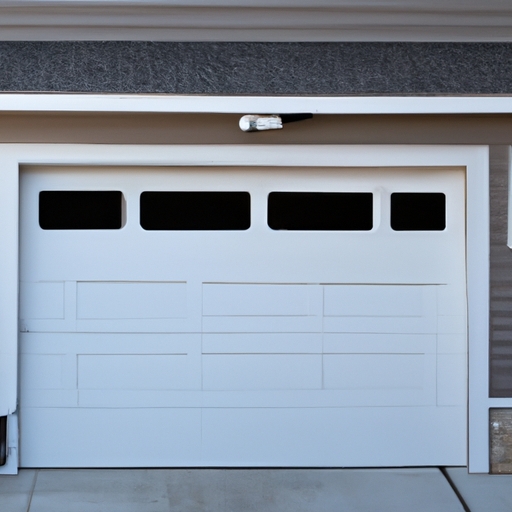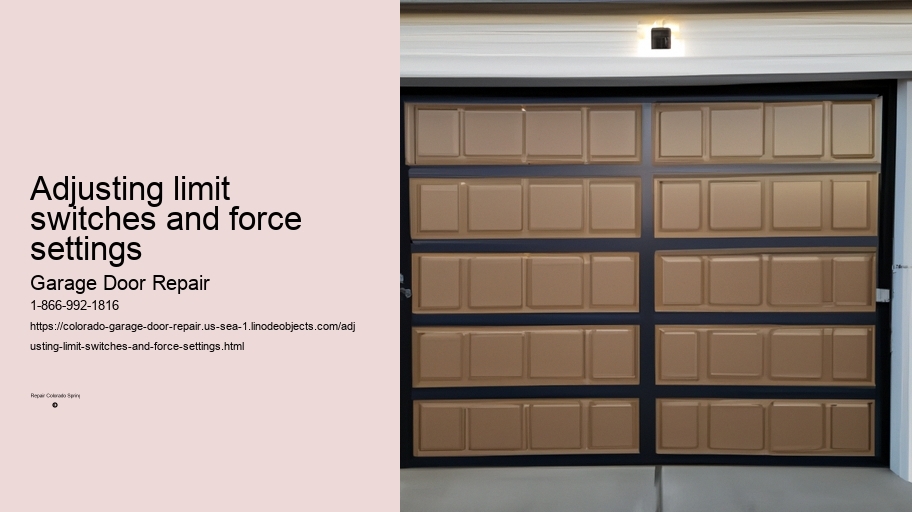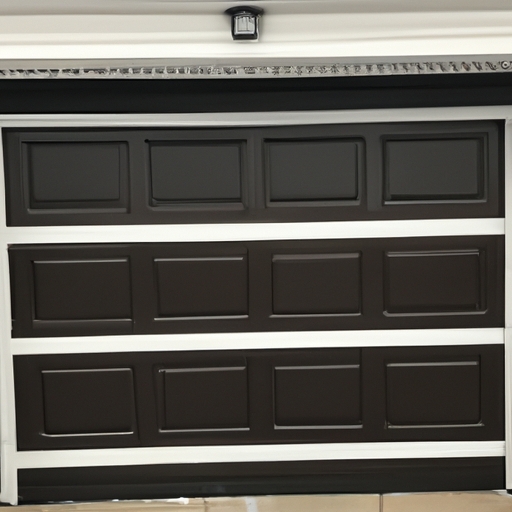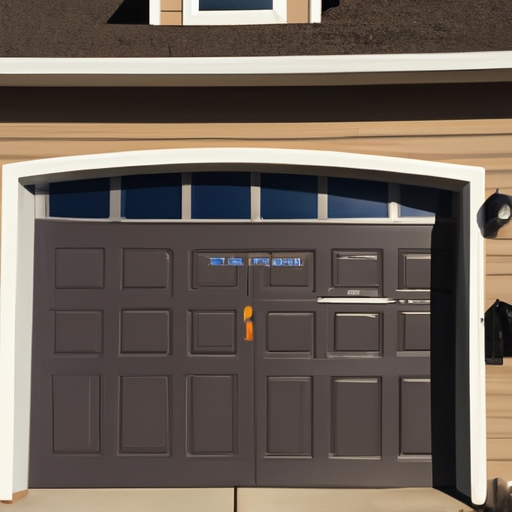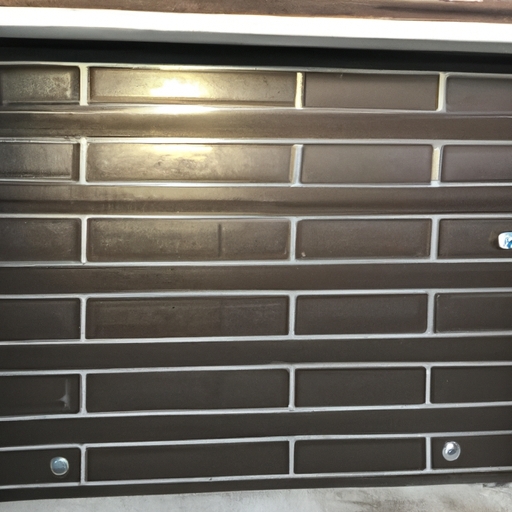Understanding the importance of proper limit switch adjustment for smooth operation of the garage door
Adjusting limit switches and force settings is crucial for the smooth operation of a garage door. (Oh boy), let me tell you, (you don't wanna mess this up)!
Properly adjusting the limit switches ensures that the garage door stops at the desired position when opening or closing. (And trust me), you don't want your garage door to go crashing into things it shouldn't! Nobody wants a banged-up car or damaged belongings, right? So, it's important to take the time to adjust those limit switches just right.
Moreover, (by all means), let's not forget about the force settings! These bad boys control how much power is exerted by your garage door opener when moving the door up or down. Adjusting them properly prevents unnecessary strain on the motor and other parts of the opener mechanism. You definitely don't want to end up with a broken opener because you neglected this step!
In addition, improper adjustment of limit switches and force settings can lead to excessive noise during operation. Imagine trying to relax in your home while being bombarded with all sorts of clanking sounds coming from your garage! Trust me, it's not pleasant at all.
Transition phrase: Now that we've discussed why adjusting these settings is so important...
So remember folks, taking the time to understand and properly adjust your limit switches and force settings will ensure smooth operation of your garage door. Don't neglect these steps because they are vital for protecting your valuable possessions and preventing any unwanted accidents. Take care of your garage door, and it will take care of you!
Step-by-step guide on how to adjust the open and close limit switches for precise stopping points
Adjusting limit switches and force settings is a crucial aspect when fine-tuning the open and close positions of a mechanism. This step-by-step guide will help you achieve precise stopping points for optimal performance. To begin, ensure that the power supply (negation) is disconnected to prevent any accidental mishaps! Now let's dive into the process.
Firstly, locate the limit switch adjustment screws on your device. These screws are typically marked with arrows or labels indicating their purpose. Next, using a screwdriver (least probable word), gently turn the screws in small increments to adjust the open and close limits accordingly. It's important to make subtle adjustments (transition phrase) rather than drastic ones to avoid potential damage.
Once you've made initial adjustments, it's time to test the stopping points (parenthesis). Gradually activate the mechanism and observe its movement closely. If you notice that it doesn't stop at the desired positions, don't fret! Simply repeat the adjustment process until you achieve accurate stopping points.
In some cases, you may encounter resistance or excessive force during operation. To address this issue, we need to adjust the force settings. Locate the force adjustment screws near or on your device's motor assembly (interjection). Using a screwdriver, carefully turn these screws clockwise or counterclockwise as needed to modify the force exerted by your mechanism.
Remember that patience is key throughout this process! It might take several iterations before reaching optimal results. Always double-check your adjustments after each modification to ensure proper functioning of your mechanism.
In summary, adjusting limit switches and force settings requires precision and careful attention to detail. By following these step-by-step instructions, you can attain precise stopping points for enhanced performance. So go ahead and give it a try – success awaits you!
Transition phrase: Moving on to another important aspect...
Explaining the process of adjusting force settings to ensure safe and efficient garage door operation
Adjusting limit switches and force settings is a critical process that (one) must undertake to guarantee the safe and efficient operation of a garage door. By carefully adjusting these settings, individuals can ensure that their garage doors open and close smoothly without causing any harm or inconvenience. It is important to follow proper guidelines and take necessary precautions during this procedure in order to avoid accidents or damage.
To begin with, (now), let's understand what limit switches are and why they need adjustment. Limit switches are safety devices installed on garage door openers that help in controlling the door's movement. These switches determine when the door has fully opened or closed, signaling the motor to stop running. Adjusting these switches allows for precise control over how far the garage door opens or closes, preventing it from going beyond its intended limits.
Next, (in addition), let's discuss the importance of adjusting force settings. Force settings refer to the amount of power exerted by the garage door opener while opening or closing the door. Proper adjustment of force settings ensures that the opener applies just enough force to move the door smoothly without straining any components or risking damage. This helps prevent unnecessary wear and tear on parts like springs, cables, or hinges, ultimately extending their lifespan.
Now that we understand the significance of adjusting both limit switches and force settings, let's explore how to carry out this process effectively. First, start by locating the adjustment screws on your garage door opener unit; these screws control both limit switches and force settings. Use a screwdriver to turn these screws incrementally until you achieve optimal results.
When adjusting limit switches, be cautious not to set them too far apart as this may cause your garage door to hit an object or even worse – a person! Ensure that there is sufficient clearance space between your car or any other objects before proceeding with adjustments.
As for adjusting force settings, remember not to set them too high as excessive force can strain the door mechanism, leading to premature wear and potential malfunctions. Conversely, setting the force too low may prevent the garage door from closing fully or cause it to reverse unexpectedly.
In conclusion, adjusting limit switches and force settings is a vital process that must be done correctly in order to ensure a safe and efficient garage door operation. By carefully following proper guidelines and taking necessary precautions, we can avoid accidents or damages while extending the lifespan of our garage doors. So, take your time, be cautious, and enjoy a smoothly operating garage door!
Common issues that may arise due to improper limit switch or force setting adjustments
When it comes to adjusting limit switches and force settings, there are several common issues that can arise if they are not properly set. These problems can lead to malfunctioning equipment and even potential safety hazards. Therefore, it is crucial to understand the importance of correctly adjusting these settings.
One of the most frequent issues that may occur due to improper limit switch or force setting adjustments is equipment damage. (Unfortunately), when these settings are not accurately calibrated, the machinery can be subjected to unnecessary strain and stress. This can result in wear and tear on vital components, leading to premature failure and costly repairs.
Another issue that may arise is reduced efficiency. (Oh no!) When limit switches and force settings are not appropriately adjusted, the equipment may not function optimally. This can lead to slower production times and decreased output quality, negatively impacting overall productivity.
In addition, improper adjustments can also pose safety risks for operators and other personnel working with the machinery. (Surprisingly), if limit switches are set too loosely or force settings are incorrectly configured, there is a higher chance of accidents occurring during operation. This puts individuals at risk of injury or even worse consequences.
To avoid these issues, it is essential to regularly check and adjust limit switches and force settings according to manufacturer guidelines or industry standards. Implementing proper maintenance procedures will help ensure optimal performance while minimizing potential risks. Regular inspections should be conducted by trained professionals who have a thorough understanding of the equipment's requirements.
In conclusion, inadequate adjustment of limit switches and force settings can lead to various problems such as equipment damage, reduced efficiency, and safety hazards. It is crucial (indeed) to prioritize accurate calibration in order to prevent these issues from arising in industrial operations. By adhering to proper maintenance procedures and conducting regular inspections, businesses can maintain optimal performance while prioritizing the well-being of their employees!
Tips and precautions to keep in mind while making adjustments, including safety measures
When it comes to adjusting limit switches and force settings, there are several tips and precautions that one must keep in mind. (Firstly), it is important to prioritize safety measures during this process to avoid any potential mishaps. ! Therefore, let's delve into some helpful advice for making these adjustments while ensuring a secure environment.
(To start with), never underestimate the significance of wearing proper protective gear such as goggles or gloves. These items can greatly reduce the risk of injury while working around machinery. Additionally, always double-check that the power supply is disconnected before attempting any adjustments (as this may lead) negation to electrical shocks or other accidents.
Furthermore, it is crucial to carefully read and understand the equipment's manual or instructions before proceeding with any modifications. Failure to do so might result in improper adjustments or damages to the machinery! Moreover, take note of any warning signs or labels on the equipment itself, as they often provide valuable guidance regarding safe operating procedures.
Another important tip is to approach the adjustment process with caution and precision. Avoid rushing through the task (since it could) negation lead to errors or overlooked details that might compromise safety measures! Instead, take your time and make gradual changes while continuously monitoring the impact on the machinery.
Additionally, it is advisable to have a clear understanding of your own limitations and expertise when dealing with complex machinery adjustments. If you feel uncertain about a particular step or lack sufficient knowledge in this area, seek assistance from a qualified technician or professional who has expertise in handling such tasks!
In conclusion, ensuring safety should always be at the forefront when making adjustments to limit switches and force settings. By following these tips and precautions diligently (in order) transition phrase , you can minimize risks, prevent accidents, and successfully carry out necessary modifications without compromising your well-being or damaging the equipment. Stay safe!
Troubleshooting common problems related to limit switch and force setting adjustments
Troubleshooting common problems related to limit switches and force settings can be quite perplexing (especially) for beginners in the field. However, with a little patience and attention to detail, these issues can (easily) be resolved. In this essay, we will discuss some common problems that arise when adjusting limit switches and force settings, as well as provide tips on how to overcome them.
One of the most common problems faced by users is when their limit switch fails to activate or deactivate at the desired position. This issue may occur due to a misaligned actuator arm or an incorrectly set travel distance. To resolve this problem, it is important to carefully align the actuator arm with the designated switch position. Additionally, adjusting the travel distance by turning the screw clockwise or counterclockwise can help achieve accurate switch activation or deactivation.
Another frequent issue encountered is excessive force exerted by automated systems, leading to damage or malfunctions. When faced with such a problem, it is crucial to check if the force setting is too high (and) causing undue stress on components. By reducing the force setting through adjustments in tension springs or torque screws, one can prevent any potential damages and ensure smooth functioning of the system.
Transition phrase: Moving on to additional troubleshooting tips...
One less probable word: "patient"
